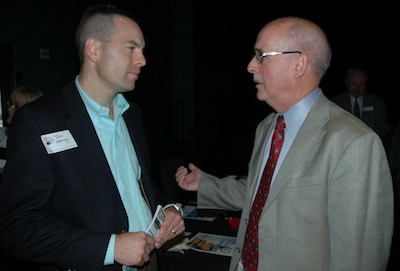TULALIP — Reid Shockey sees North Snohomish County’s ongoing population growth leading to greater traffic congestion, and while traffic jams are aggravating enough on their own, Shockey fears they could derail the economic engine of the region.
Shockey, president of the Snohomish County Committee for Improved Transportation, recently spoke to the Greater Marysville Tulalip Chamber of Commerce about how SCCIT was formed in 1983 and has evolved to address the problems of transportation in the area.
“Prior to 1983, everyone had their own constituent groups, and they weren’t thinking about how they related to one another,” Shockey said. “Today, our plans are coalescing into a developing consensus for the future. Within the county, we’re seeking the prosperity of partnerships by figuring out how to come together while competing with each other.”
Shockey pointed to Snohomish County’s roles in the economies of the Puget Sound, the Pacific Northwest and the United States as evidence of its global importance, which he asserted makes it essential that local companies that produce and ship goods around the world can address such basic questions as how their employees will get to work, how their businesses will send supplies where they’re needed on time, and how North Snohomish County can develop its own strategies “without letting Seattle run your lives.”
Shockey identified aerospace, transit, rail and freight as priorities for North Snohomish County, and urged those in attendance at the Chamber’s Business Before Hours on July 27 to factor such transportation issues into every economic, political and community decision that they make, because “transportation affects every aspect of your lives.”
SCCIT favors commercial air service at Paine Field and improving cross-connections through the north-south “ladder” corridor of roads in Snohomish County, the latter by ensuring that more bus routes connect to Everett. Shockey likewise touched upon the controversy of coal trains possibly coming to Marysville by acknowledging the debate while asserting that “we’ve got to make sure that it allows the rest of the traffic to operate.”
Shockey cited the projected population growth of Arlington, from 29,780 now to 40,185 in 2025, as but one example of the need to explore different modes of transportation. At the same time, he admitted that it would cost nearly $3 billion within the next 10 years just to target bottlenecks and infrastructure gaps, and almost $11 billion over the next 30 years to complete the multimodal strategy being coordinated between Snohomish County’s cities and transit agencies and SCCIT.
“So, the question is, ‘What can you do?’” Shockey said. “Track the legislation, pick out one or two projects that you think would make a huge difference in transportation, and testify positively to your elected officials. They need to know what you’re for, rather than just what you’re against, and you need to speak to them with one voice.”
“We need a list of priorities for Snohomish County, delivered with one voice, for which projects we should do,” agreed state Sen. Mary Margaret Haugen.
For more information, log onto http://sccit.wordpress.com.


